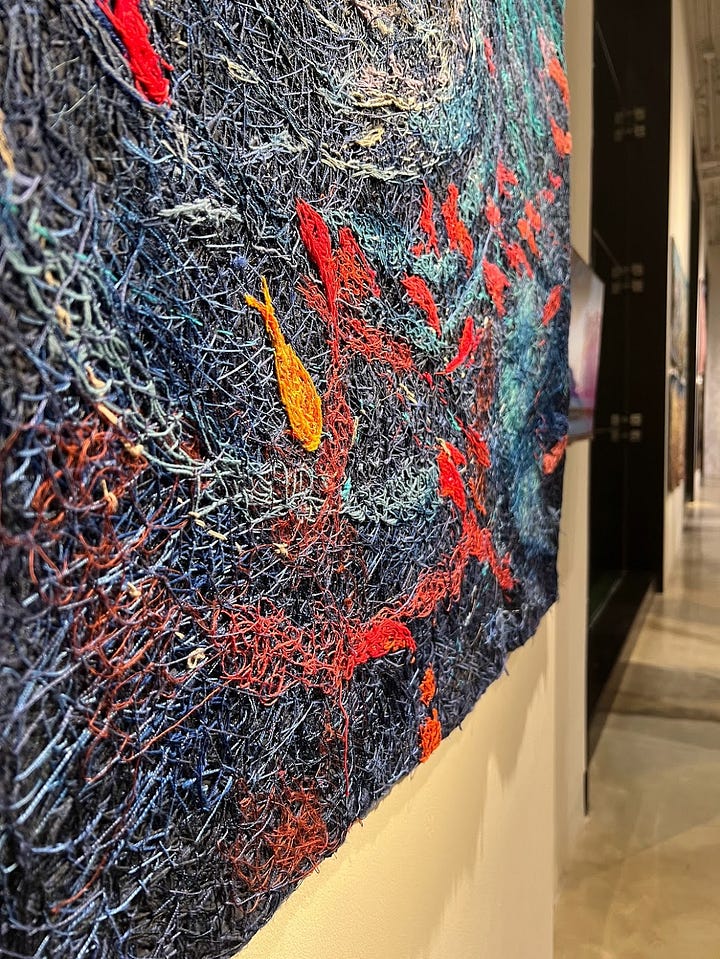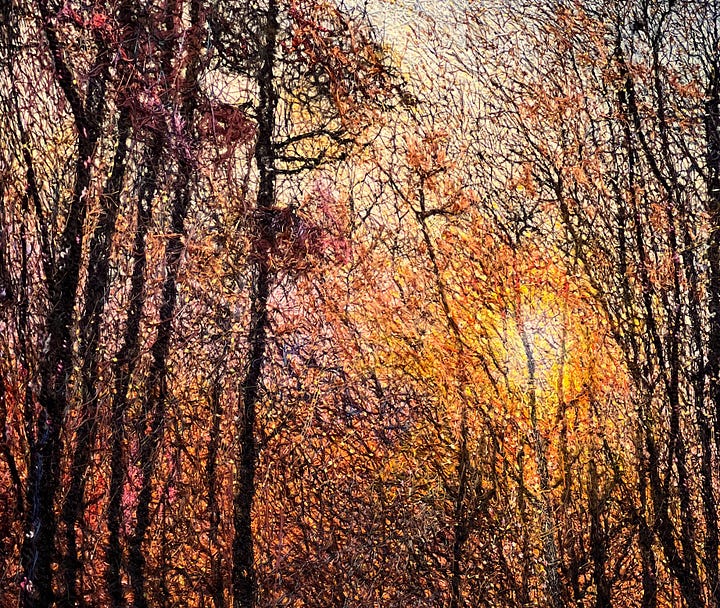Finding Secrets and Clues in Artwork
I wish I was a better connoisseur of visual art. I rarely find meaning in paintings, I'm rarely moved by sculptures. So when something actually clicks for me it feels like a revelation.
A book to read: HESTER, by Laurie Lico Albanese
HESTER is an inventive reimagining of the woman who inspired Hester Prynne (you know, the pregnant girl who had to wear the scarlet A in that Hawthorne novel you probably had to read in high school).
Albanese’s protagonist (the Hester-to-be), is Isobel Gamble, a wildly talented seamstress, aided/cursed by her family’s generational condition of synesthesia.
Isobel and her debt-ridden, druggie of a husband move to America in the early 1800s. Her husband immediately disappears (along with her secret stash of cash), leaving Isobel space to sew and ponder a relationship with Nathanial Hawthorne, the town’s enigmatic writer. It doesn’t go especially well for her.
Both Nathanial and Isobel are haunted by witch trials that dominated their ancestor’s realities. A dual timeline runs through the book exploring the fate of Isobel’s grandmother.
In addition to the patriarchy, the book also touches on slavery. Isobel’s savior throughout the book is a nearby Black family. Although Salem (where, of course, the book is set) is in the North, the Fugitive Slave Act ensured that no one was safe. The Underground Railroad and Isobel’s skills as a seamstress weave together to give the book a powerful conclusion.
I highly recommend this one. The historical details are completely immersive, the writing is lyrical, and the characters are all perfectly rendered.
A place to explore: Wherever Shin-hee Chin is showing her art.
Last October I was in Tulsa for the First Friday Art Crawl. My cousin and I were about to head home when we passed by 108 Contemporary where Shin-hee Chin was showing her work.
Her work pulled us into the studio as if we were threads on her needle.


Shin-hee Chin is a fiber/mixed-media artist and Visual Arts Professor at Tabor College in Kansas. Luckily for me, she was showing her work in Tulsa last fall. Her needlework is mesmerizing.
You know how people describe that Shakespeare works on two levels: the rich folks in the box seats got one message and the riffraff on the floor in front were treated to more intimate jokes? That’s how Chin’s work is. When you stand back, her tapestries depict a gorgeous scene. When you get up close, new details emerge.
I’m so glad I read HESTER before seeing Chin’s work. I’m also so glad that I didn’t have much opportunity to talk to Chin during her show because I probably would have babbled incoherently about the Underground Railroad and the book and feminism and left her totally confused.
So instead, I spent a quiet hour inside the studio, reveling at the similarities between Isobel from the book and Chin’s art in front of me. Searching for the hidden symbols and messages in Chin’s art, I couldn’t help but feel like Isobel and her friends, creating and finding life-saving directions and messages in 19th-century tapestries.
Both Chin and HESTER’s Isobel were/are immigrants to America, and motherhood closely followed their international moves. Politics, pregnancy, immigration, and feminism, all prevalent in HESTER also show up in Chin’s work. In her Artist’s Statement, Chin writes:
In my work, I attempt to carve out what I proudly call a feminine territory in which the voices of effaced and silenced women reverberate, and to translate the experiences of women in a way that people of different ethnic backgrounds and cultural experiences can understand. For that purpose, I utilize needle, thread, and fabric to call into question the deep-seated bias that women’s work is menial, marginal and undesirable. I convert the conventional “feminine” activity of needlework into a useful medium for the making of art.
Isobel would certainly agree.
A lesson to teach: Humanism in Art
If I was an ELA teacher, I’d read sections of HESTER in conjunction with The Scarlet Letter. If I was an American history teacher, I’d connect this book to the Underground Railroad.1 However, the closest my World History teach-self can get is to think about art in general. Luckily I just taught a pretty kick-ass lesson on medieval and Renaissance art in Europe.
If you live for the “lightbulb” moment of student learning, get excited for some flickers of light. The lesson is hands-down the easiest way to teach students about Humanism.
A lecture is involved. Brace yourself. Here are the Google slides and here is the student worksheet for students to take notes.
First, I tell the students that at the end of the class, I’ll give them copies of four paintings. They’ll need to order them based on the date were likely created. Students will doubt their future ability to do this, not being art historians and all.
Then, teach students about halos, the hieratic scale, landscape, and perspective. Each concept has a Google slide with a definition, examples, and information on how those aspects of art looked during the Middle Ages compared to the Renaissance. I explain each, students take notes, and we look at examples. It takes about 20 minutes.
Then, I print the last four slides. In color! Yes, I know how hard it is to convince your school that you really do need color copies. Good luck with that. Also, cut the dates off the copies. I print one copy for each table group. Then, I have students order the pictures. There is space for students to record the order on the back of their notes.
Students will automatically use the words “halo,” “hieratic scale,” “landscape,” and “perspective” as they order the pictures. If your admin wants to hear students using content-specific vocabulary, this is the lesson for you. And, students will be amazed at their ability to easily and confidently order the paintings.
Wham, bam! You’ve taught your students about humanism. Good work!
A Civics lesson I recently taught Seniors a couple of weeks ago mentioned Harriett Tubman and over half of my students had never heard of her. Do we not teach Harriett Tubman anymore?!? I know there has been a push to teach students about African American leaders other than Rose Parks, MLK, and Tubman…but has the conductor of the Underground Railroad really been cut out of the curriculum?





What incredible art you've shared here and an amazing connection between the two. Now, I've got a book to read, to add to the Ted talk! Thank you.
Thanks for sharing images of Shin-hee Chin's work. It looks amazing!